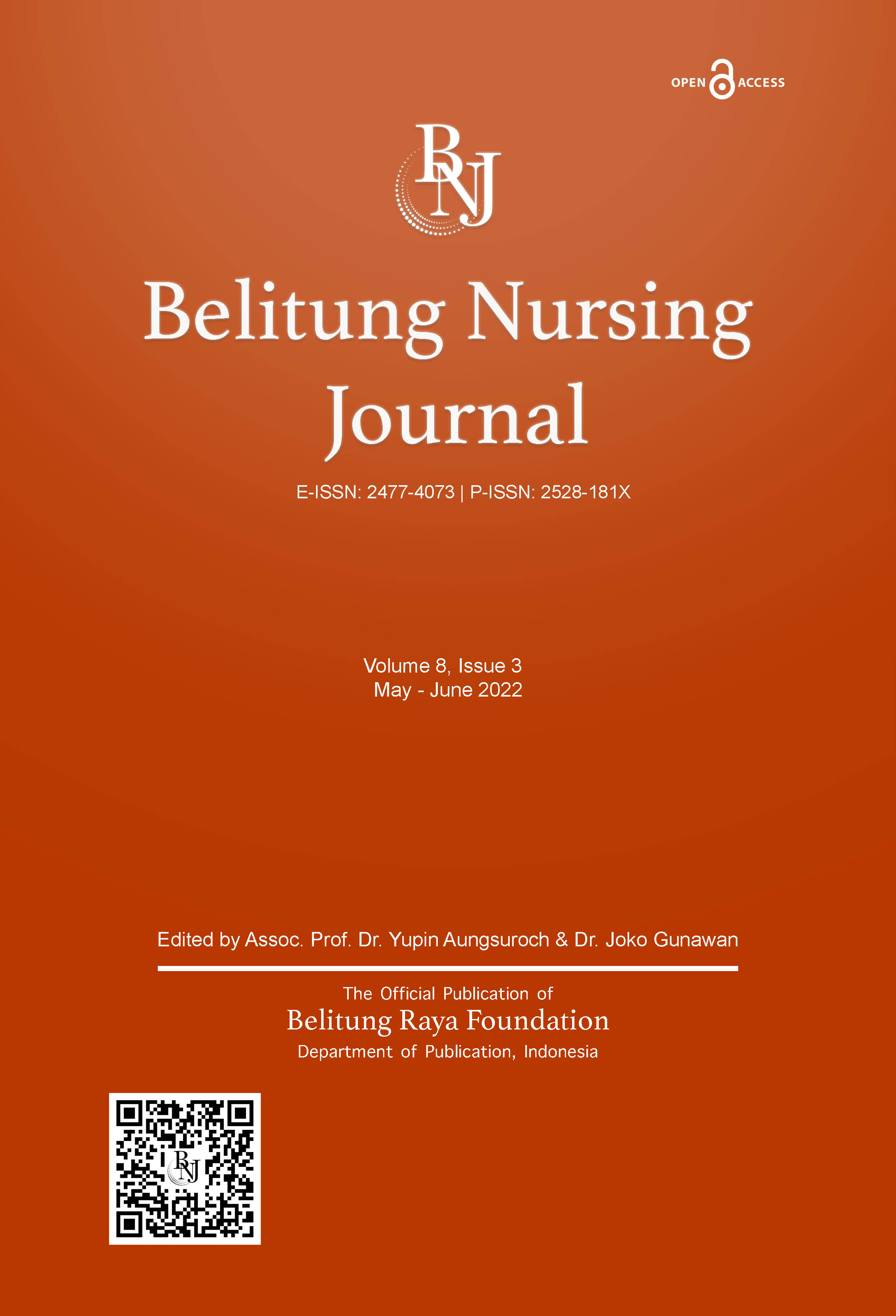Background
Naturally, aging is a process that occurs to everyone (E. Feliciano et al., 2022). The increasing age of a person can become something that can cause various problems both physically and psychologically. Loneliness is a problem that most often arises in the elderly caused of being abandoned by their partner, living in a different place with their family, and being left by their peers (Valtorta & Hanratty, 2012). Loneliness in older adults is unique because it impacts complex health problems. In addition, it can lead to various physical and psychological health problems, including depression, sleep disturbances, stress, suicidal ideation, and a decreased immune system (Niu et al., 2020; Sutinah, 2020). Berg-Weger and Morley (2020) also revealed that loneliness in older adults could cause problems in the quality of life, cognition, depression, cardiovascular disease, disability, and increased mortality.
Previous studies have found several factors influencing loneliness among older adults. Berg-Weger and Morley (2020) showed that living in a rural area, poor functional status, lower-income and education, lack of friends, and being poorly understood by others are the risk factors related to loneliness in older adults. These conditions require attention to solve and prevent the results that might be caused every older adult will have a poor quality of life and increasing institutionalization. In addition, psychological, cultural and situational, and spiritual factors are some causes that can lead to lonely older adults (Mulyadi & Juanita, 2016).
One effort to overcome loneliness can be from support from the social environment, namely the closest people such as family, friends, and neighbors (A. Feliciano et al., 2022). As the most relative support system, family support is the primary support system for older adults in maintaining their health. The size of family support significantly affects loneliness in older adults (A. Feliciano et al., 2022; Ningsih & Setyowati, 2020). In addition, Oktavianti and Setyowati (2020) indicated that living with children and grandchildren can help older adult feels happier and prevent older adults from the conditions that can make them feel alone.
Apart from family support, social support from other people is also essential (A. Feliciano et al., 2022). Social support itself refers to the comfort, attention, appreciation, and assistance that other people or groups provide to individuals (Czaja et al., 2021). Older adults need to interact with other people to obtain social support, such as making social contacts. It is found that some older adults feel happier and less lonely if they get social support from all parties (Czaja et al., 2021). In addition, Chen et al. (2014) showed social support is essential and critical environmental factor enhancing the older adult’s health, participation, and security.
Although social support has been identified to solve the older adult’s loneliness, the discussion of the types of social environment support is still lacking. Therefore, a scoping review is needed to identify and discuss social environment support to overcome loneliness among older adults. The results of this review will benefit healthcare professionals, including gerontology and family nurses, to provide the best-fit nursing care to maintain the health status and quality of life of older adults.
Methods
Study Design
A scoping review outlined by Arksey and O'Malley (2005) was used, which consisted of five steps: (1) identifying the research question, (2) identifying relevant studies, (3) study selection, (4) charting the data, and (5) collating, summarizing and reporting the results.
Search Methods
Five databases were used for the search: Embase, CINAHL, Cochrane, PubMed, and Google Scholar. The keywords used varied using Mesh and Emtree terms in each database for searching (Table 1). The detail of the search strategy can be seen in the supplementary file. The inclusion criteria of the articles were all article types that discussed the social environment of the older adults, published between 2012 to early 2022 (to get the updated information), and full text in English and Bahasa Indonesia. The exclusion criteria were the articles that discussed older adults with mental health disorders and papers from proceedings. The database search was carried out on 1 February 2022 on the Embase and CINAHL databases, while on PubMed, Cochrane, and Google Scholar, a search was conducted on 2 February 2022.
| Criteria | Synonym | Controlled Vocabulary |
|---|---|---|
| Population | ((“aged patient” OR “aged people” OR “aged person” OR “aged subject” OR “elderly” OR “elderly patient” OR “elderly people” OR “elderly person” OR “elderly subject” OR “senior citizen” OR “senium” OR “aged, 80 and over” OR “centenarian” OR “centenarians” OR “nonagenarian” OR “nonagenarians” OR “octogenarian” OR “octogenarians” OR “very old” OR “older adult” OR “older adults” OR “Elderly” OR “Old Persons” OR “Older Persons” OR “80 and Over, Aged” OR “80 and over” OR “Aged over 80” OR “Over 80” OR “aging” OR “Retired”)) | “Aged” OR “Aged,80 and over” (Mesh and Emtree) |
| Concept | ((“Environment*” OR “environment determinants” OR “home environment” OR “environment, social” OR “interpersonal climate” OR “social climate” OR “social context”)) | “Social Environment” OR “Environment” (Mesh and Emtree) |
| Context | ((“homesickness*” OR “alienation” OR “desolation” OR “heartache” OR “solitude” OR “abstinence symptom” OR “abstinence symptoms” OR “abstinence syndrome” OR “cessation symptoms“ OR “discontinuation symptom” OR “discontinuation symptoms” OR “discontinuation syndrome” OR “withdrawal symptom” OR “withdrawal symptoms”)) | “Loneliness*” OR “withdrawal syndrome” (Mesh and Emtree) |
Screening
All authors contributed to the article screening. Three authors (DMA, RI, and W) screened the title, three authors (WN, SS, and R) screened the abstracts, and the other three authors (RWR, W, RI, and DMA) read full texts.
Data Extraction
The data extraction was done using a table consisting of the author’s name, year, country, objective, and result.
Data Analysis
The data were analyzed based on the Arksey and O'Malley (2005) guideline in line with the objective of this review to identify who gave the support to the older adults and the types of support to overcome or prevent older adults’ loneliness.
Results
Search Results
The total articles retrieved from the five databases were 2,410 articles. In the title screening, there were 258 papers removed because of duplication or redundancy. Further investigation resulted in 1,660 articles removed because of no full text, and 132 were excluded due to conference abstracts only. Among the remaining 360 articles, ten articles were finally included that best fit the inclusion criteria (Figure 1). In addition, a Prisma diagram was used based on Haddaway et al. (2021).
Articles’ Characteristics
Most of the included studies’ research design was a longitudinal study. In addition, four studies used cross-sectional studies; one study used a systematic review, one descriptive study, and one quasi-experimental study. The retrieved studies were conducted in six countries: China, Taiwan, Ireland, West Virginia, Egypt, and Turkey (Table 2).
| Authors and year of publication | Country | Purpose | Sample | Results |
|---|---|---|---|---|
| Theeke et al. (2012) | West Virginia | To describe loneliness and examine the relationship between loneliness, depression, social support, and quality of life. | 60 older adults | Feelings of alienation, depression, and loneliness are associated with depression and quality of life in older adults. Providing support in the form of attention to the older adults is support from the family not to feel lonely. |
| Schnittger et al. (2012) | Irlandia | To identify the bio-psychosocial and cognitive risk factors of loneliness emotionally and socially. | 624 community-dwelling | Family support should manage stress, neuroticism, living alone, and depression as biopsychosocial and cognitive factors. |
| Chen et al. (2014) | China | To identify factors of loneliness as well as sources of social support. | 26 articles | Marital status is an often-mentioned factor related to loneliness. However, presence and affection are support that couples can overcome loneliness in older adults. |
| Liu et al. (2016) | China | Investigating the effect of loneliness on depression and further testing the mediating outcome of social support | 320 older adults | Depression related to loneliness can solve through social support. |
| Tian (2016) | China | Investigating the effect of intergenerational social support on the well being of the older adults | 429 older adults | Older adults with high social support showed a significant increase in self-esteem. |
| Zhao et al. (2018) | China | To assess the prevalence of depressive symptoms, explore the relationship between loneliness and depressive symptoms, and investigate the indirect and direct effects of social support | 323 participants | Loneliness is strongly associated with depression. The resilience of older adults is a direct factor related to overcoming loneliness. Social support is an indirect factor in overcoming loneliness. |
| Chen et al. (2019) | China | Examine the direct effect of social support and the mediating development of coping styles on loneliness and depression in the older adults | 1,646 older adults | With an emphasis on the importance of social networks and coping styles, the well-being of older adults can improve by enabling them to become more resilient. |
| Eskimez et al. (2019) | Turkey | Identifying loneliness and level of social support of older adults living in nursing homes | 70 older adults | Older adults who live in nursing homes feel lonely, and their loneliness scores decrease with increasing social support from the family in the form of attention. In this case, increasing social support can prevent loneliness in older adults. |
| Elsayed et al. (2019) | Mesir | To determine the relationship between social support, loneliness, and depression among parents. | 150 older adults | The most significant factor for depression is loneliness. However, family and friends support older adults to overcome loneliness in love and involvement. |
| Tang et al. (2022) | China | This study explores the effect of parenting on depression in older adults in China by gender and marital status. Explore forms of integration between parenting and depression through child mediation | 3540 older adults | Depression is a threatening health problem in China. Parenting has a positive effect on depression. Intergenerational support from a child significantly impacts the parenting of grandchildren and depression in older adults, where grandchildren can reduce the likelihood of older adults in China experiencing loneliness. |
Analytical Findings
As shown in Table 3, we identified four groups of social environment support that affect loneliness in older adults, including families, friends, neighbors, and governments. The support given by families includes affection, attention, emotional support, motivation, and financial support. Friends’ support includes peer groups, partnership, advice, and appreciation. Neighbors’ support includes work around the house, society involvement, and emergency support. Last, the government’s support includes healthcare facilities and community programs.
| Social environment support | References |
|---|---|
Families’ support
|
(Chen et al., 2019; Chen et al., 2014; Elsayed et al., 2019; Eskimez et al., 2019; Liu et al., 2016; Schnittger et al., 2012; Tang et al., 2022; Theeke et al., 2012; Tian, 2016; Zhao et al., 2018) |
Friends’ support
|
(Chen et al., 2019; Chen et al., 2014; Elsayed et al., 2019; Liu et al., 2016; Schnittger et al., 2012; Zhao et al., 2018) |
Neighbors’ support
|
(Chen et al., 2014) |
Government’s support
|
(Chen et al., 2014) |
Discussion
Loneliness is a problem that older adults often experience. Loneliness in older adults can be caused by several things, such as being abandoned by a partner, abandoned by friends, and entering retirement (Czaja et al., 2021). To overcome these conditions, the role of the environment as a support system is significant (Liu et al., 2016). This is because the environment where older adults live, both physically and socially, is a critical factor in the psychological condition of older adults. Therefore, excellent social environment support affects the health condition of older adults (Liu et al., 2016).
According to our findings, as shown in Table 2 and Table 3, four groups provide social environment support, namely families, friends, neighbors, and government supports, with various types of support. Each will be discussed in the following explanations.
Families’ support
The family is the smallest element in the community, with bonds of togetherness and emotional ties. Family bonding is a bond born from every individual in which there is an element of care and love under any circumstances (A. Feliciano et al., 2022; Schnittger et al., 2012). Therefore, a family can be good support for older adults to avoid isolation and loneliness as well as cover financial issues. In addition, family love and togetherness from spouses, children, and grandchildren can help the older adults feel happy and comfortable and prevent them from feeling lonely (A. Feliciano et al., 2022; Teh et al., 2014; Zhao et al., 2018). Furthermore, couples can provide support such as compliments, appreciating for partner’s achievements, and giving gifts to their partners (Teh et al., 2014).
Other forms of support include accompanying the older adults for walks, visiting friends or friends, playing with grandchildren, making snacks, directly giving pleasure, and feeling empowered in doing some light activities (Chen et al., 2014). Attending attentively and listening actively when the older adults tell stories is a form of support and affection that all family members can give. Another form of attention that can be provided is the fulfillment of daily needs, from an economic perspective, in clothing, food, and shelter from children, grandchildren, or other families (Chen et al., 2014). The emotional condition is a normal response experienced from every event, whether happy or unhappy. Several ways to respond to emotions include exploring emotions/elicitation, acknowledging the feeling, being empathetic, not abandoning or not ignoring emotions, and exploring and legitimacy of emotions in the elderly (Chen et al., 2014).
Emotional support from the family in the form of the presence of a grandson also directly gives happiness (Teh et al., 2014). A sense of emotion, pleasure, comfort, and peace can decrease loneliness and improve the quality of life of older adults (Zhao et al., 2018). The family can support them by motivating them to do activities that support the improvement of health conditions, reminding them to take medication, providing healthy food, and maintaining adequate sleep. Older adults who are still active and empowered can be involved in several social activities, such as recitation, heart exercise with association organizations, and social gathering activities. Social activities in their home provide an environment that can make the older adults feel not alone and socialize well. However, it is again dependent on the family members to motivate the older adults to remain active in their lives even though they are not young anymore. Comprehensive family support can improve older adults’ physical and psychological health (Teh et al., 2014).
Affection is another important family member’s role for older adults. Affection is a fascinating pattern of life because it connects two or even more people. It can be interpreted as the softness of the heart and the sensitivity of feelings of affection towards others (Chen et al., 2014). Some examples of affection that can be shown to older adults (parents, in this case) include contacting and visiting parents regularly, cleaning their homes, taking parents to walk to the park, and talking or being an active listener. However, many family members cannot take care of their parents because of their busy schedules earning money to feed the family (Syadiyah et al., 2020). As a result, many elderlies feel sad because no one can accompany them. Therefore, the presence of the nurses is very important for the elderly to help with their daily activities (Sadang & Palompon, 2021). However, in providing care, a nurse is required to be able to provide attention, empathy, and affection to the elderly. In addition, nurses play a role in educating families on how to give attention to the elderly (Padmiati & Diyanayati, 2015; Sadang & Palompon, 2021).
To sum, the types of support from families to older adults include affection, attention, emotional support, motivation, and financial support (Chen et al., 2019; Chen et al., 2014; Elsayed et al., 2019; Eskimez et al., 2019; Liu et al., 2016; Schnittger et al., 2012; Tang et al., 2022; Theeke et al., 2012; Tian, 2016; Zhao et al., 2018).
Friends’ support
Friends are a form of support system that can make the older adults not feel alone because they can share each other and do the activities and have social relationships with their age groups (Elsayed et al., 2019; Liu et al., 2016; Nguyen et al., 2016). The presence of friends in the community can make the older adults reduce the feeling of loneliness, increase confidence, improve skills usually done by the older adults, and feel more valued and comfortable (Liu et al., 2016; Nguyen et al., 2016; Zhao et al., 2018). Therefore, it is recommended to have older adult groups in the community, such as religious groups, sports groups, and social groups. However, in these groups, they can fill their spare time being active with each other, and that attention, appreciation, advice, or assistance will be created.
According to Zhao et al. (2018), friends are individuals with the same social group, closeness, and level of maturity. The formation of a peer group is one of the community activities that can be proposed by a nurse in a community. Nurses are required to be able to carry out their role in fostering elderly community groups so that the elderly have productive activities (Soewignjo et al., 2020). In addition, peer support helps someone with the same maturity level share the same story and fate and strengthen each other so that individuals who receive assistance feel comfortable and safe (Nguyen et al., 2016). Friends have a good effect on the happiness of older adults. A friend can replace a life partner. The elderly need care or support from their friends and health services to control their health (Prayogi, 2016).
Neighbors’ support
Neighbors are the closest support system in the neighborhood where the older adults live. Neighbors can be friends and family substitutes for the elderly when family members such as their children no longer live with them (Chen et al., 2014). Social support from neighbors can improve the psychological well-being of older adults (Chen et al., 2014) and help meet older adults’ daily needs, either voluntarily or with a sense of kinship. The involvement of neighbors in meeting the needs of older adults is a form of attention that positions itself as part of the older adults’ family environment (Seifert & König, 2019).
In addition, another condition that cannot be ignored is the involvement of neighbors in emergency situations that can occur in older adults. The risk of the older adults falling or experiencing sudden poor health conditions often makes neighbors act as supervisors and support systems (Chen et al., 2014). The role of neighbors can also be a benchmark in the welfare of the older adults when the family’s carrying capacity requires assistance from the environment around the house. The existence of neighboring communities built voluntarily, such as Posbindu (integrated guidance post in Indonesia) (Putri & Andriyani, 2018) and creating gardening places, can help the lonely older adults. However, visits made by neighbors can create an atmosphere of intimacy, another form that can make the older adults feel that they still have meaning in life and do not feel lonely (Chen et al., 2014). In other words, maintaining good relations with neighbors is something that cannot be ignored because neighbors play an important role when the older adults live far from their children, grandchildren, and other siblings (Seifert & König, 2019). This is also the role of nurses to remain older adults and continuously maintain social interactions with their neighbors (Syadiyah et al., 2020).
Government’s support
The government program in terms of financial subsidies and quality, fast, and friendly health services is one form of support carried out to improve the welfare and health of older adults (Syadiyah et al., 2020). For example, in Indonesia, the government, through primary health care facilities, has developed Posyandu (Integrated Service Post) across the country to support the elderly by conducting routine health screening and regular exercise, providing medical care and psychological consultation/services, building more senior adults cadres, and developing recreational areas such as parks and sports venues can also help overcome loneliness in the older adults (Syadiyah et al., 2020). In Posyandu, all older adults will be gathered; therefore, they can share with each other and develop social relationships. In addition, primary healthcare centers also provide home visits as the role of community nurses to take care of the society, especially the elderly who lack health access.
Apart from Posyandu, another alternative of government support is nursing homes, which provide housing, health, fitness, and skills services (Syadiyah et al., 2020). Telephone service is also offered for older adults to communicate with a family member. However, inadequate health service facilities and infrastructure and the availability of public facilities are essential to note. Everything facilitated by the government aims to reduce loneliness in older adults.
The facilities in the nursing home are similar to those in residential houses. The government tries to provide physical, psychosocial, and spiritual support to make older adults comfortable. However, although the older adults live in both nursing homes and residential houses offered by the government, many still feel lonely because they live separately and are in a different place from their beloved families. Therefore, nursing homes and residential houses are probably fit for those without a family. But for those who still have a family, the nursing homes and residential houses can be a choice for a temporary stay and later returning home to their family (Wong et al., 2017).
Implications and Limitations of This Study
Families, friends, neighbors, and government play essential roles in preventing or overcoming loneliness among older adults. Therefore, nurses and other healthcare professionals can provide direction and education to the older adults, families, and the communities to care for each other, both physically and psychologically. It is expected this study could be the basic knowledge for further research to consider, especially the types of social environment support to develop interventions to reduce loneliness among older adults. In addition, a causal model may be necessary to understand and examine all constructs and factors influencing loneliness in older adults.
We were also aware that this study might have some limitations, such as limited access to searching and finding the articles, and some essential articles might be missing because of the unmatched keywords.
Conclusion
Families, friends, neighbors, and governments are considered the important factors in preventing and reducing loneliness among older adults. The variables include affection, attention, emotional, motivation, financial, peer group, partnership, advice, appreciation, work around the house, society involvement, emergency, home care facilities, and community programs, which may potentially affect loneliness but need further validation.










